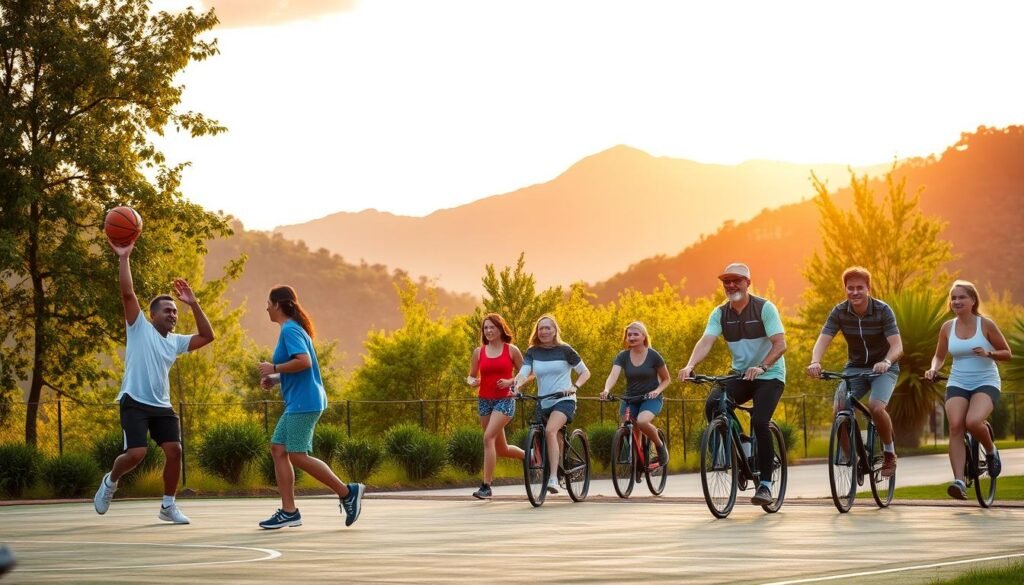Engaging in sport and physical activity is crucial for overall wellness and personal growth. Regular exercise not only improves physical health but also has a significant impact on mental well-being.
By understanding the benefits of exercise and the impact of physical activity, individuals can make informed decisions about their health and fitness routines. This knowledge enables people to adopt a healthier lifestyle, enhancing their overall quality of life.
Key Takeaways
- Regular exercise improves physical health and mental well-being.
- Physical activity has a significant impact on overall wellness.
- Understanding the benefits of exercise is crucial for making informed health decisions.
- Adopting a healthier lifestyle enhances overall quality of life.
- Engaging in sport and physical activity promotes personal growth.
Understanding Physical Activity
Understanding the concept of physical activity is essential for adopting a healthier lifestyle. Physical activity encompasses a broad range of movements and exercises that contribute to overall fitness and well-being.
What is Physical Activity?
Physical activity refers to any bodily movement that requires energy expenditure, such as walking, running, swimming, and dancing. It’s not just about exercising; it’s about staying active in various ways throughout the day. Regular physical activity is known to have numerous fitness benefits, including improving cardiovascular health, strengthening muscles, and enhancing flexibility.
Types of Physical Activities
There are several types of physical activities that cater to different needs and goals. These include:
- Aerobic exercises, such as cycling and jogging, which improve cardiovascular health.
- Strength training exercises, like weightlifting, that help build muscle.
- Flexibility exercises, including yoga and stretching, which enhance flexibility and balance.
By incorporating a mix of these activities into your daily routine, you can achieve a balanced level of fitness and promote overall health through sports and physical activity.
Health Benefits of Regular Exercise
Engaging in regular physical activity can significantly enhance overall health. By incorporating exercise into daily routines, individuals can experience a wide range of benefits that improve both physical and mental well-being.
Physical Health Benefits
Regular exercise is known to improve cardiovascular health by strengthening the heart and increasing blood flow. This can lead to lower blood pressure and a reduced risk of heart disease. Additionally, physical activity helps in maintaining a healthy weight, reducing the risk of obesity-related conditions.
Key Physical Health Benefits:
- Improved cardiovascular health
- Weight management
- Enhanced muscular strength and endurance
Mental Health Advantages
Exercise is not only beneficial for physical health; it also has a significant impact on mental well-being. Physical activity stimulates the production of endorphins, which are chemicals in the brain that act as natural painkillers and mood elevators.
Regular physical activity can help reduce symptoms of anxiety and depression, improve sleep quality, and enhance cognitive function. The mental health advantages of exercise are a crucial aspect of overall wellness.
| Mental Health Benefit | Description |
|---|---|
| Reduced Stress | Exercise helps in reducing stress levels by releasing endorphins. |
| Improved Mood | Physical activity enhances mood by stimulating the production of neurotransmitters. |
| Better Sleep | Regular exercise can lead to improved sleep quality. |
Long-term Health Outcomes
The long-term benefits of regular exercise include a reduced risk of chronic diseases such as diabetes, certain types of cancer, and osteoporosis. Consistent physical activity can lead to a longer, healthier life.
Long-term Outcomes:
- Reduced risk of chronic diseases
- Improved longevity
- Enhanced quality of life in older age
Sport as a Tool for Social Interaction
Beyond physical health benefits, sports play a significant role in enhancing social bonds. Engaging in sports and physical activities provides a unique platform for individuals to interact, build relationships, and develop a sense of community.
Building Community Through Sport
Sports have a remarkable ability to bring people together, creating a shared sense of purpose and belonging. Whether it’s through participating in local sports leagues, joining a fitness class, or attending sporting events, sports provide numerous opportunities for social interaction.
“The power of sports to unite people and create a sense of community is undeniable. It’s a universal language that transcends cultural and linguistic barriers.”
Enhancing Relationships
Participating in sports activities not only fosters new relationships but also strengthens existing ones. Team sports, in particular, encourage communication, trust, and camaraderie among teammates.
- Improves communication skills
- Fosters trust and reliance among team members
- Encourages mutual support and camaraderie
Teamwork and Collaboration
Team sports exemplify the importance of teamwork and collaboration. By working together towards a common goal, individuals learn valuable skills such as problem-solving, strategy, and leadership.
| Skill Developed | Description |
|---|---|
| Problem-Solving | Ability to analyze situations and devise effective solutions |
| Leadership | Capacity to guide and motivate team members towards a common objective |
| Strategy | Skill in planning and executing tactics to achieve success |
In conclusion, sports and physical activities are not just about staying fit; they are also powerful tools for social interaction. By enhancing relationships and fostering a sense of community, sports contribute significantly to our overall well-being and quality of life.
The Role of Sports in Youth Development
Sports play a pivotal role in shaping the youth of today, imparting valuable life skills that extend beyond the playing field. Through participation in sports, young individuals can develop a wide range of abilities that are crucial for their overall development.
Fostering Life Skills
Engaging in sports helps young people acquire essential life skills such as discipline, teamwork, and perseverance. These skills are not only beneficial in the context of sports but also in other areas of life, including academics and personal relationships.
“The lessons we learn from our experiences in sports – teamwork, discipline, and perseverance – are invaluable and stay with us throughout our lives.”
Some of the key life skills fostered through sports include:
- Teamwork and collaboration
- Discipline and responsibility
- Perseverance and resilience
- Leadership and communication
Improving Academic Performance
Participation in sports has been linked to improved academic performance among young individuals. The discipline and time management skills required to balance sports and academics can lead to better grades and overall academic success.
| Aspect | Impact on Academic Performance |
|---|---|
| Discipline | Enhances time management and focus |
| Teamwork | Fosters collaboration and mutual support |
| Physical Activity | Improves cognitive function and concentration |
Building Confidence and Self-esteem
Sports participation can significantly boost a young person’s confidence and self-esteem. Achievements in sports can translate to other areas of life, helping young individuals feel more capable and self-assured.
The benefits of sports in youth development are multifaceted, contributing to the growth of well-rounded individuals who are better equipped to succeed in various aspects of life.
Physical Activity and Mental Well-being
Regular exercise is increasingly recognized as a crucial element in maintaining good mental health. Engaging in physical activity not only improves physical health but also has a profound impact on mental well-being.
Stress Relief Through Exercise
Exercise is a natural stress reliever. Physical activity stimulates the production of endorphins, also known as “feel-good” hormones, which help alleviate stress and anxiety. Regular physical activity can help individuals manage stress more effectively, leading to a better quality of life.
Reducing stress through exercise can be achieved through various activities, such as running, yoga, or even a brisk walk. The key is to find an activity that you enjoy and can commit to regularly.
The Connection Between Mood and Movement
The relationship between physical activity and mood is complex. Exercise influences mood through several mechanisms, including the release of neurotransmitters like serotonin and dopamine, which play a crucial role in mood regulation.
Regular physical activity can help reduce symptoms of depression and anxiety by promoting these neurotransmitters. Moreover, exercise provides a healthy distraction from negative thoughts, further enhancing its positive impact on mood.
Promoting health through sports and physical activities is not just about physical benefits; it’s also deeply connected to mental well-being. By incorporating exercise into daily routines, individuals can significantly improve their mental health and overall quality of life.
The Economic Impact of Sports
The economic influence of sports is multifaceted, encompassing job creation, event hosting, and merchandise sales. The sports industry has grown significantly over the years, contributing substantially to the global economy.
Job Creation in the Sports Industry
Job Creation in the Sports Industry
The sports industry is a significant source of employment, offering a wide range of job opportunities. From professional athletes and coaches to event managers and marketing professionals, the industry supports a diverse workforce.
- Professional athletes and coaches
- Event management and staff
- Marketing and sponsorship professionals
- Journalists and media personnel
Economic Benefits of Hosting Sporting Events
Economic Benefits of Hosting Sporting Events
Hosting major sporting events can have a profound economic impact on the host city or country. These events attract tourists, create temporary jobs, and stimulate local economies through infrastructure development and spending on accommodations, food, and other services.
| Economic Indicator | Pre-Event | During Event | Post-Event |
|---|---|---|---|
| Tourism Revenue | $10 million | $50 million | $15 million |
| Job Creation | 1000 | 5000 | 1500 |
| Infrastructure Spending | $50 million | $200 million | $70 million |

The economic benefits of hosting sporting events are not limited to the short-term gains. They can also lead to long-term infrastructure development and an increase in the host city’s global profile, potentially attracting more business and investment in the future.
Barriers to Participation in Sport
The journey to staying active is often fraught with challenges that prevent participation in sports. Various factors contribute to these barriers, making it difficult for individuals to engage in physical activities that are essential for their overall wellness.
Socioeconomic Factors
Socioeconomic factors play a significant role in determining one’s ability to participate in sports. Income level and education are critical determinants that affect access to sports facilities, equipment, and training. Individuals from lower socioeconomic backgrounds often face significant challenges in accessing these resources.
For instance, the cost of joining a gym or purchasing sports equipment can be prohibitive for many. Additionally, lack of education about the benefits of sports and how to participate can further exacerbate the issue.
Access to Facilities and Equipment
Access to appropriate facilities and equipment is another crucial barrier to participation in sports. Many communities lack sufficient sports infrastructure, such as playgrounds, gyms, and swimming pools, making it difficult for residents to engage in physical activities.
Furthermore, the availability and quality of sports equipment can also be a limiting factor. For example, in some areas, it may be challenging to find affordable or rental equipment, forcing individuals to either forego participation or invest heavily in purchasing their own gear.
Addressing these barriers is essential to promoting an active lifestyle and ensuring that everyone has the opportunity to engage in sports, regardless of their socioeconomic status or geographical location.
Promoting an Active Lifestyle
Promoting health through sports and physical activity is a community-wide effort that requires the involvement of individuals, local organizations, and government initiatives. By working together, communities can create environments that encourage and support active living.
Encouraging Participation in Local Sports
Local sports programs play a vital role in promoting physical activity among community members. These programs not only provide opportunities for exercise but also foster social connections and a sense of community. To encourage participation, local sports organizations can offer beginner-friendly classes, flexible scheduling, and inclusive programs for diverse age groups and abilities.
Benefits of Local Sports Programs:
- Improved physical health
- Enhanced mental well-being
- Opportunities for social interaction
- Development of teamwork and leadership skills

Tips for Staying Active Daily
Incorporating physical activity into daily routines can be straightforward with a few simple strategies. Here are some tips for staying active:
| Tip | Description | Benefits |
|---|---|---|
| Schedule workouts | Plan your day to include time for exercise | Ensures consistency, improves time management |
| Find an exercise buddy | Exercise with a friend or family member | Boosts motivation, enhances enjoyment |
| Try new activities | Experiment with different types of exercise | Prevents boredom, discovers new interests |
By implementing these strategies and supporting local sports initiatives, individuals can maintain an active lifestyle and enjoy the numerous physical activity advantages, including improved health, increased energy levels, and enhanced overall well-being.
Staying fit is not just about personal achievement; it’s a community effort that benefits everyone involved.
The Future of Sport and Physical Activity
The world of sport and physical activity is on the cusp of a revolution, driven by technological innovations and shifting trends in fitness and recreation. As we look to the future, it’s clear that the importance of sport and physical activity will only continue to grow.
Technological Advancements
Advances in wearable technology and virtual fitness platforms are transforming the way we engage in physical activity. Wearable devices, such as those produced by Fitbit and Garmin, allow individuals to track their progress and stay motivated. Virtual fitness platforms, like Peloton and Nike Training Club, offer a range of workouts and training programs that can be accessed from anywhere.
Changing Fitness Landscapes
Evolving trends in fitness and recreation are also shaping the future of sport and physical activity. The rise of functional training and high-intensity interval training (HIIT) reflects a growing interest in efficient and effective workouts. As our understanding of the benefits of exercise continues to grow, it’s likely that we’ll see even more innovative approaches to physical activity emerge.
By embracing these changes and staying informed about the latest developments, we can continue to promote the importance of sport and physical activity and help people around the world lead healthier, more active lives.
FAQ
What are the benefits of regular exercise for mental health?
Regular exercise has been shown to have a positive impact on mental health by reducing stress, anxiety, and depression. It improves mood, enhances cognitive function, and promotes overall well-being, which are all essential for maintaining good mental health.
How can I stay motivated to exercise regularly?
Staying motivated to exercise regularly can be achieved by setting realistic goals, finding an enjoyable physical activity, and exercising with a friend or family member. Additionally, tracking progress and rewarding yourself for milestones can help maintain motivation.
What types of physical activities are suitable for different age groups?
Different age groups have varying needs and capabilities when it comes to physical activity. For example, children and adolescents can engage in high-intensity activities like team sports, while older adults may prefer low-impact exercises like walking, yoga, or tai chi. It’s essential to choose activities that are enjoyable and suitable for one’s age and fitness level.
How does physical activity impact overall wellness?
Physical activity is a crucial component of overall wellness, contributing to physical health, mental well-being, and social connections. Regular exercise can improve cardiovascular health, reduce the risk of chronic diseases, and enhance mental health, leading to a better quality of life.
What role do sports play in youth development?
Sports play a significant role in youth development, teaching valuable life skills like discipline, teamwork, and perseverance. Participation in sports can also improve academic performance, build confidence, and enhance self-esteem, providing a strong foundation for future success.
How can I incorporate physical activity into my daily routine?
Incorporating physical activity into your daily routine can be achieved by scheduling exercise into your daily planner, finding activities that you enjoy, and making small changes to your daily habits, such as taking the stairs instead of the elevator or walking to work.
What are the economic benefits of hosting major sporting events?
Hosting major sporting events can bring significant economic benefits, including job creation, increased tourism, and revenue generated from merchandise sales and sponsorship deals. These events can also stimulate local economies and promote the host city’s brand.
How can socioeconomic factors affect access to sports facilities and equipment?
Socioeconomic factors, such as income level and education, can significantly impact access to sports facilities and equipment. Individuals from lower socioeconomic backgrounds may face barriers to participation, including limited access to facilities, equipment, and training programs.
What are some tips for staying active daily?
Staying active daily can be achieved by incorporating small amounts of physical activity into your daily routine, such as taking a short walk during your lunch break, doing a few jumping jacks during commercial breaks, or taking the stairs instead of the elevator.
How can community-based initiatives promote an active lifestyle?
Community-based initiatives can promote an active lifestyle by providing accessible fitness programs, encouraging participation in local sports, and creating opportunities for social interaction through physical activity. These initiatives can help motivate individuals to stay active and adopt a healthier lifestyle.
